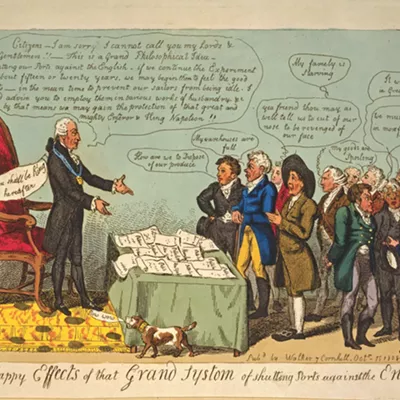So it turns out that Mr. Fox "Fair and Balanced" News was a fan of the controversial German filmmaker Leni Riefenstahl. Gabriel Sherman reports this nugget in his new biography of Roger Ailes, The Loudest Voice in the Room. Liberal critics, focusing entirely on Riefenstahl's Nazi paean, Triumph of the Will, have pounced. "Aha," they chortle. "We always knew that Ailes was a closet Nazi."
Ironically, they are taking a knee-jerk, broad-brush page right from the Ailes playbook. Be this as it may, my interest goes not to how Goebbels and Hitler used Riefenstahl's artistry and technique to influence Germans, but rather to how Riefenstahl's artistry and technique influenced Ailes — her famous camera angles, for example.
Ailes was never going to be an artist, but as for technique? Now that was altogether a different matter. During the 1968 presidential campaign, he talked himself onto Richard Nixon's staff and once there borrowed from Riefenstahl's filming techniques to create illusion — and from that propaganda. Production of propaganda; this would become Ailes' life's work.
Ailes started Fox News in 1996 and set about hiring reliable script readers, the more attractive the better. To no surprise, he avoided serious, independent-minded journalists — no Walter Lippmanns or Seymour Hershes; obviously the Edward R. Murrows had to be given a wide berth; even a Walter Cronkite could prove troublesome. For comic relief, he needed a few attention-getters, which explains both Bill O'Reilly and Glenn Beck. They would serve as the "entertainment."
What resulted was a actually a form of reality TV, similar to what we see on The Real Housewives of Orange County or Duck Dynasty. Call it "Reality News," brought to you by your "Fox News Fair and Balanced Reporting Team." It would turn out to be neither fair nor balanced, of course.
Before Fox, there was "Roger Ailes the Campaign Advisor." Working exclusively for Republicans, Ailes combined clever — if often misleading and vacuous — one-liners with Riefenstahl-esque visuals to successfully caricature opponents. Recall the 1988 commercial featuring candidate Michael Dukakis peering from the tank, wearing that oversized helmet that made his head appear so small. (Those camera angles again.) The visual is what made the ad. And the point? "Do you want this dweeby guy running the Pentagon?" Half-truths, innuendo and visual caricature for sure, but it worked, and in Ailes' world, that's what counts.
He didn't invent the devastating visual commercial — arguably, the Democrats did that with their infamous "Daisy" ad against Goldwater in 1964. Certainly, though, Ailes took negative campaigning to a new level. But as troubling as all of Ailes' visual attack ads have been, might we agree that campaigning is one thing, whereas news should be another?
You would think so, but in Ailes' world? Nope, there's no difference; it's all seamless. Everything is fair game.
Nor has Ailes ever been about the exchange of ideas. He is into selling an illusion, a party line — propaganda. From the Monica Lewinsky fiasco to the run-up to George W. Bush's invasion of Iraq, to the invasion itself, to Barack Obama, the network has engaged in relentless propaganda campaigns. It has kept alive false perceptions, from "birthers" to "death panels" to "Benghazi" — perceptions that derive not from fact but from the manipulation of contrived illusion with appeal to myth and conspiracy. It is all about contrived effect pitched to the most easily manipulated and the predisposed voters, also known as "the choir."
The media problem, obviously, isn't just Fox News. FCC Chairman Newton Minow called TV a "vast wasteland" a half-century ago. But Ailes and Fox have become the model, the archetype and the inspiration. Fox is where real housewives and real ducks meet the "real" news. And that's the most fundamental challenge posed by "The World According to Roger."
It's all escapism, enhanced visually through technologies that Riefenstahl didn't have, taking us to places where reality loses definition; where it becomes but a blur, producing what political Columbia University sociologist Todd Gitlin refers to as "disposable emotion." Gitlin elaborates:
The media add up to a machinery of distraction, sensation and stimulus, and yet institutionally the protections that the media enjoy, their legal and political position in our society, are predicated on a very different model of the purposes and significance of media — namely, one in which the media are carriers of debate in which the media are intended not for steady and unbroken stimulus but for enlightenment. They are for the clarification of the public good.
Walter Lippmann, Edward R. Murrow and Walter Cronkite understood and lived up to that higher calling implicit in the First Amendment. Roger Ailes has used those same protections as cover for one of the great con jobs in American history. ♦






















